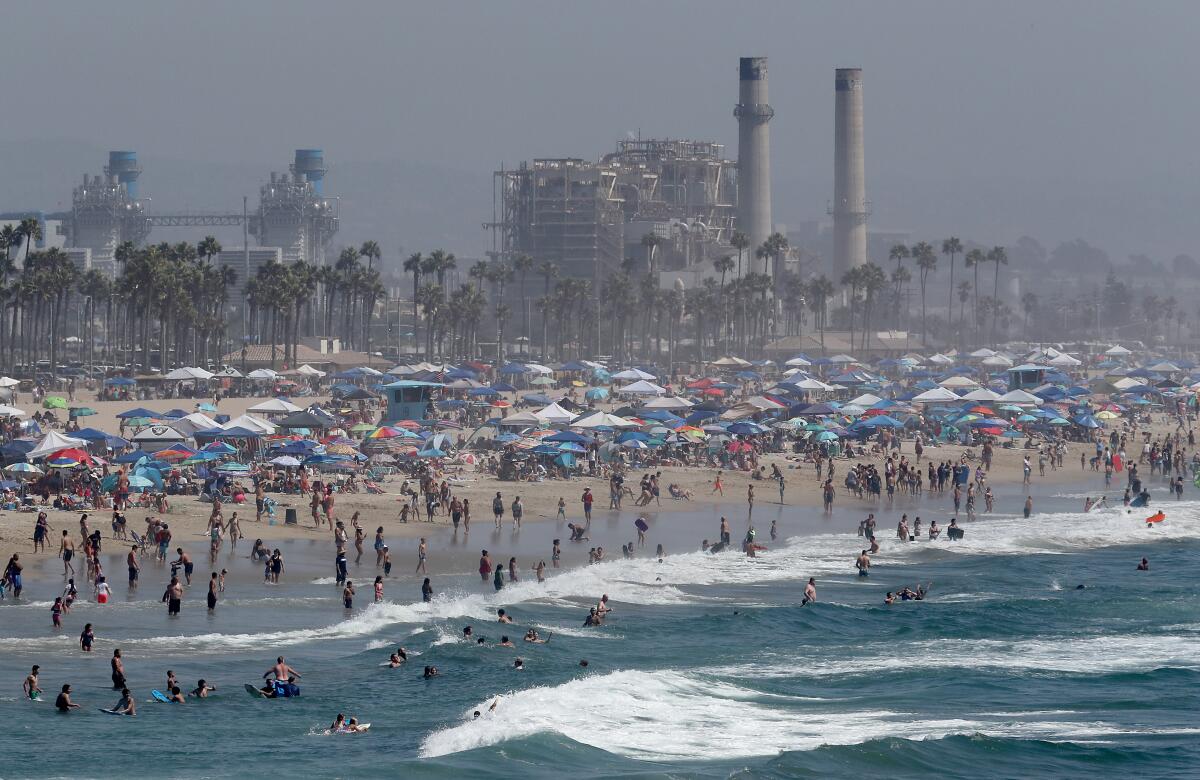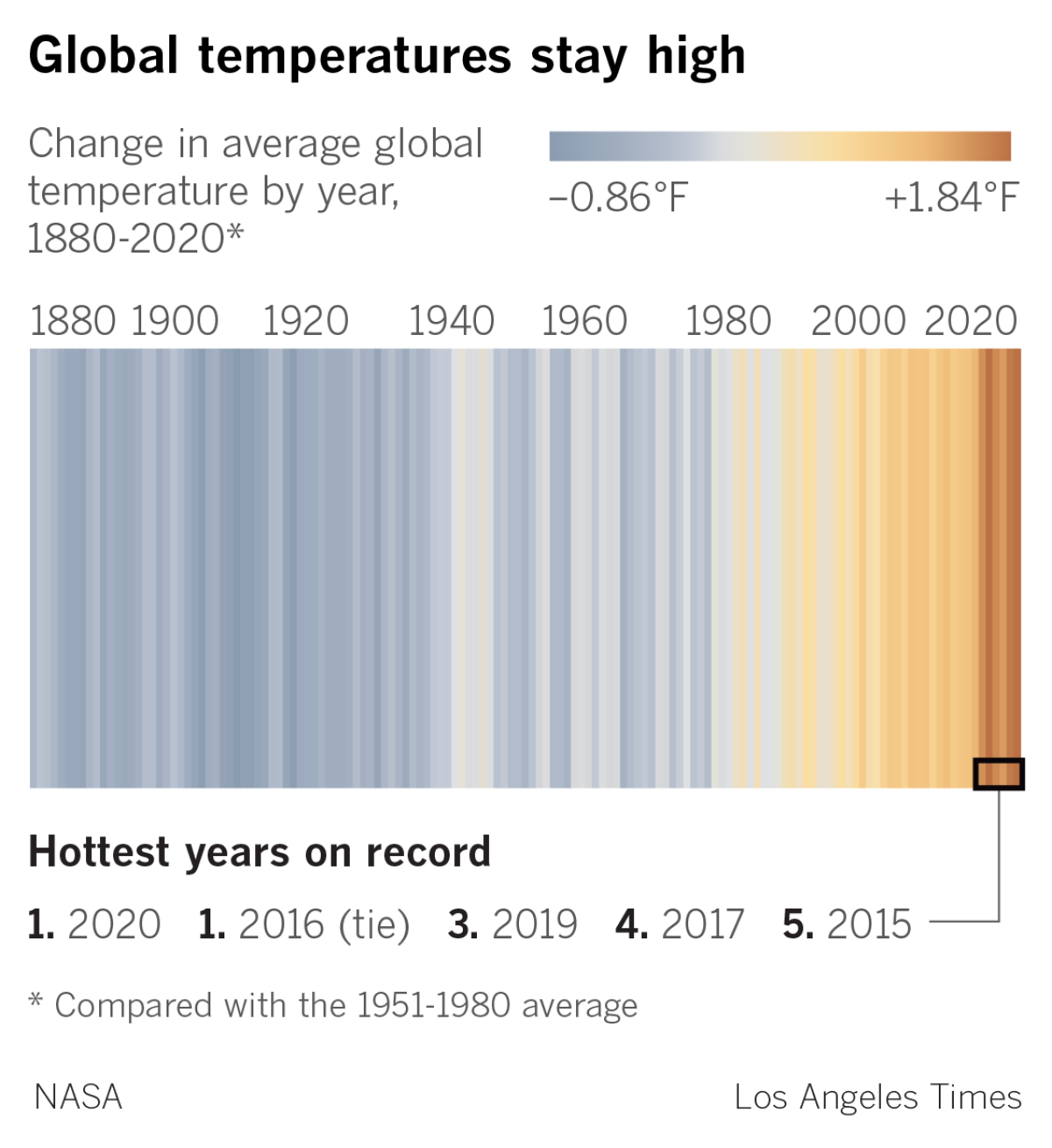2020 ties 2016 as hottest year on record, even without warming boost from El Niño

- Share via
Global warming pushed temperatures into record territory in 2020, in effect tying 2016 as the hottest year on record, according to data released Thursday by U.S. science agencies.
Last year’s average global surface temperature was 2.2 degrees Fahrenheit above the late 19th century average, according to NASA. It was the fifth consecutive year of more than 2 degrees above that base line.
Indeed, the seven hottest years in 140 years of record keeping are the last seven. In descending record order, they are 2020 and 2016, 2019, 2017, 2015, 2018 and 2014.

The fact that the planet’s average temperature reached such heights — absent the short-term warming effect of El Niño — reveals the unmistakable signal of human-caused greenhouse gas emissions, researchers said. It also shows the ever-increasing dominance of these emissions as global warming continues to accelerate.
“It’s a testament to the power of the long-term trends,” said Gavin Schmidt, a climate scientist at the NASA Goddard Institute for Space Studies, who worked on the analysis.
The alternating cycle of El Niño and La Niña in the Pacific Ocean, which repeats roughly every five years, has long been the biggest natural driver of year-to-year fluctuations in the Earth’s temperature. A strong El Niño can boost global temperatures by about 0.4 degree.
The previously undisputed hottest year, 2016, started off with a powerful El Niño that helped boost temperatures that entire year.
Zeke Hausfather, a climate scientist with the nonprofit research organization Berkeley Earth, which conducted an independent global temperature analysis that came to similar conclusions, said it is “startling” to see 2016-level warmth in the absence of El Niño.
“It shows that five years of human CO2 [carbon dioxide] emissions can have nearly as large an impact on global temperatures as a super El Niño event, and reinforces the fact that our emissions are what is driving the rapid warming of the planet over the past few decades,” Hausfather said.
“Now, every decade we’re adding the equivalent of a permanent, strong El Niño event to the climate system,” Hausfather added. “That’s why what was a super El Niño event two decades ago, in 1998 for example, would be a remarkably cold year today.”
L.A. began 2020 with a clean-air streak but is ending with its worst pollution in years
NASA, the National Oceanic and Atmospheric Administration and other research organizations that compile global temperature rankings rely on much of the same data, including measurements from weather stations, ships and buoys spread across the planet. However, they use independent analyses and methods that can yield slightly different results.
NASA’s analysis found 2020’s global average temperature was slightly above 2016, but so close that it was within the margin of error. Other organizations, including NOAA, ranked 2020 as the second-hottest year.
“It’s certainly warmer now than at any time in the past 2,000 years at least, and probably much longer,” said Russell Vose, chief of the analysis and synthesis branch for NOAA’s National Centers for Environmental Information.
Vose said the planet is closing in on 2.7 degrees Fahrenheit, or 1.5 degrees Celsius, of global warming since preindustrial times. That’s the more stringent of two limits world leaders established under the 2015 Paris agreement in an effort to avert catastrophic levels of climate change.
The effects can be detected all around us in the form of record-breaking heat waves, ever more extreme wildfires, health-damaging air pollution and the increasing length of the hurricane season.
Global surface temperature, which includes readings over the land and sea, is only one measure of global warming’s acceleration.
The average temperature over the land made 2020 “unambiguously the warmest year” in observations going back to 1850, according to the analysis by Berkeley Earth.
The warming trend in Earth’s oceans is even clearer. They absorb more than 90% of the excess heat trapped by the gases humans are spewing into the atmosphere, and ocean temperatures have set records nearly every year. A separate scientific analysis of ocean heat content, also released this week, showed that temperatures in the upper 2,000 meters of ocean water reached new highs, with the hottest five years all occurring since 2015.
“The amount of energy going into the ocean every second is roughly equivalent to the energy from five Hiroshima bombs,” Vose said.
Record heat. Record acres burned. Sky-high air pollution. The extremes California has experienced in recent weeks all have one thing in common: They were made worse by climate change.
Calculating a global average temperature of course masks uneven heating of the planet. The Arctic, for instance, is heating up roughly three times as fast as other parts of the globe, and has already seen temperatures rise about 5 degrees above preindustrial levels.
Siberia stood out as a clear hot spot in 2020, reaching temperatures more than 30 degrees above average. One community there reached 100.4 degrees, the first time an official weather station in the Arctic has exceeded 100 degrees, according to NOAA.
Europe also logged its warmest year on record. In the U.S., the lower 48 states had their fifth-hottest year, according to NOAA’s analysis.
The cooling effect of a moderate La Niña, which emerged in late 2020 and dropped temperatures sharply in November and December, is the main reason 2020 did not end up surpassing 2016, Hausfather said.
It also means that 2021 will probably be slightly cooler, relatively speaking. Hausfather and other climate scientists still think this year is likely to end up somewhere between the third- and fifth-warmest year. Once the next strong El Niño hits, global temperatures will almost certainly jump to record heights, they said.
2020’s record-equaling temperatures occurred during a year in which COVID-19 brought a 7% decline in greenhouse gas emissions globally, and a 10.3% drop in the United States, the largest percentage decrease since World War II. Although that is impressive, it will not have much of a direct impact on global temperatures because of the cumulative effect of carbon dioxide, which builds up and traps heat for years and years after its release.
The United Nations warned in a report last month that the pandemic-caused dip in emissions will have a “negligible long-term impact on climate change” and does not alter the world’s path toward a catastrophic rise in temperatures, which is on track to exceed 5.4 degrees by the end of this century unless pollution is cut swiftly and dramatically.
Slowing global warming, experts say, will instead require a sustained and systemic transformation of our economy to nearly eliminate the burning of fossil fuels. That’s something entirely different from last year’s pollution reductions, which were largely the product of stay-at-home orders that sent driving and air travel plummeting amid a deadly and economically devastating pandemic.
“The challenge that we have to reduce carbon dioxide emissions is really large and should not be downplayed,” Schmidt of NASA said. “We also saw that there’s a limit to what individual action can do. ... That has an impact, but it’s not large enough to turn this thing around.”









